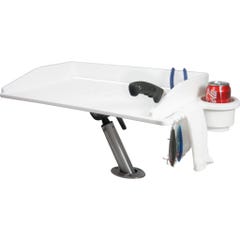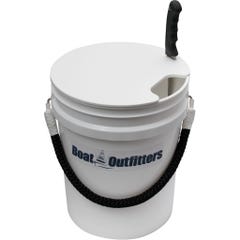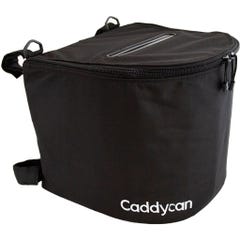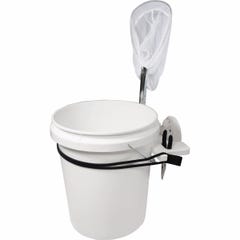Scalloping Trip Checklist
June 17, 2022 8 min read


It’s tough to imagine a better low-key, family-and-friends boating activity than scalloping on Florida’s west coast. Yes, it can get crowded and a little crazy early in the season and on weekends, but there’s a good reason for that. The clear, grassy flats are beautiful, the water is calm, the runs to and from the grounds are short and scenic, and harvesting scallops is challenging enough to be fun but easy enough that kids as young as five or six can do it. And of course the scallops themselves are absolutely delicious.
Still, planning your first DIY scalloping trip can be a little intimidating, especially if you’re traveling from outside Florida or another part of the state and aren’t familiar with local waters and conditions. Here’s a handy checklist for preparation and packing.
Contents
- 1. Boat Gear and Preparation
- 1.1 Dive Flag
- 1.2 Substantial Swim Ladder
- 1.3 Quality Ground Tackle
- 1.4 Shade
- 1.5 PFDs, Signals, Etc.
- 1.6 Extra Fenders and Dock Lines
- 2. Scalloping Gear
- 3. Scallop Cleaning and Storage
- 3.1 Shade
- 3.2 Livewell or Cooler
- 3.3 Gallon Measure
- 3.4 Cleaning Tools
- 3.5 Cash
- 3.6 Garlic and Butter
Boat Gear and Preparation
Having the right equipment and accessories on board will not only keep you on the FWC’s good side but can also make your day a lot easier and more enjoyable.
Dive Flag
This is an absolute must, for both compliance and safety. FWC and local law enforcement maintain a heavy presence on the scallop grounds, and if you have snorkelers in the water without a dive flag — or even with a dive flag that’s improperly displayed — chances are good that you’ll get a visit.
Florida statutes require that a dive flag displayed on a boat must be at least 20” x 24”. Flags on floats towed by snorkelers must be at least 12” x 12”. All flags must have a wire stiffener or some other device that holds them “open” even with no breeze.
Flags must be “displayed from the highest point of the vessel.”
Finally, flags must be “displayed from the highest point of the vessel.” That means if you have a T-top, hardtop, or Bimini, the flag must be above the top. Many commercially available flags are made to drop into standard rod holders, so if you have a T-top or hard top, it’s easy to drop a flag into one of your rod holders. With a Bimini top, you may need to securely zip tie a rod holder to one of the legs. Regardless, figure out ahead of time where and how you’ll display your flag. Don’t wait until you’re on the water with the anchor down to try and rig something.
Substantial Swim Ladder
One thing about scalloping, you’ll be getting in and out of the water a lot. A substantial ladder is essential. If you don’t already have a ladder and/or platform and you don’t have time to add one, consider a portable gunwale ladder.
Climbing up your lower unit or hauling yourself aboard like a walrus all day is no fun. Neither is climbing any kind of rope contraption.
Quality Ground Tackle
You’ll also be anchoring a lot, usually in dense grass, which can be a challenge for bargain basement fluke-style anchors. You’ll want a good quality fluke, claw, plow, or Sea Claw style anchor with an appropriate length and size of chain. The current can be surprisingly strong on the grounds, and it’s not infrequent to see a boat drag anchor and drift away while the crew is in the water.
Power-Poles and other powered or manual shallow water anchors can be convenient for short stops in shallower water, but always be prepared for the boat to drift. Never leave the boat unattended without a real anchor that is securely set. You’ll typically be scalloping in 4’ to 8’ of water.
Shade
It gets hot out there sitting on the anchor! Some kind of shade is crucial. If your boat doesn’t have a Bimini, T-top or other covering, figure something out. It can be as simple as a cheap beach umbrella that you drop in a rod holder after anchoring.
PFDs, Signals, Etc.
Again, law enforcement maintains a heavy presence on the scallop grounds, which is a good thing. But be sure you have all your ducks in a row well before your trip.
That means properly sized PFDs for everyone on board plus a throwable, all required visual distress signals (check expiration dates!), fire extinguisher (also not expired) and working horn or whistle.
Extra Fenders and Dock Lines
If you plan to leave your boat in the water at a marina, resort or rental property, be prepared with some additional gear for tying up.
You never know exactly what the set up is going to be, and an extra fender or two can come in very handy.
Scalloping Gear
The gear required to actually harvest scallops is fairly simple. A few additions can make you more comfortable and more successful.
Good-fitting Mask and Snorkel — You’ll be spending a lot of time in your mask and snorkel. Invest a little time and money at a reputable dive shop (not on Amazon) and get something that fits right. After a few hours, the difference in comfort will be worth it.
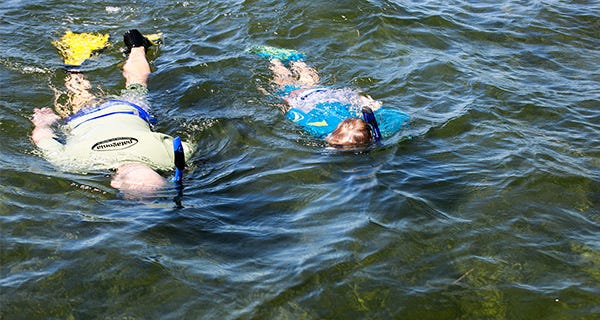

Sun Protection — Floating around face-down for hours on end with your bare back and shoulders awash in water is a recipe for a big-time sunburn. You can apply and reapply (and reapply!) good-quality waterproof sunscreen to your back, shoulders and neck and probably avoid getting burned.
But it’s easier and more effective to wear a wetsuit top, rash guard, or SPF fishing shirt to protect your back. Of course, you’ll still need to sunscreen your ears, the back of your neck, the backs of your legs, and, if you’re bald, the back and crown of your head.
Mesh Bags — These don’t have to be anything fancy, but every person snorkeling should have one. You can get the nice ones from the dive shop with the metal closures, or you can order a six-pack from Amazon for less than $10.
Fins — You can manage without fins, but you’ll cover a lot more ground with them. Long scuba-style fins designed for scissor-kicking slowly in a relatively straight line are unnecessary since you don’t need to cover much distance and can even be a bit of a hindrance in shallow water.
Inexpensive, rubber full-foot fins are more comfortable, easier to get on and offer and easier to maneuver in tight quarters.
Weight Belt — While not really necessary, a bit of weight makes it a lot easier to cruise along above the tops of grass, especially if you’re carrying some built-in flotation.
Pool Noodles — A pool noodle under the belly or armpits is a great confidence booster for kids or timid adults. Tether the noodle to the snorkel’s wrist with six or seven feet of parachute cord so it doesn’t drift away when they dive.
Fishing License — You do need a Florida saltwater recreational license to scallop from a private boat unless you’re exempt from license requirements. Those exempt include kids under 16 and residents 65 or older. Refer to FWC regulations for complete information. Expect to be checked!
Scallop Cleaning and Storage
Fresh bay scallops are among the best of all seafoods, so you’ll want to take good care of your catch.
Livewell or Cooler
If your boat has a good livewell with adequate flow to keep your scallops alive, that’s the best place to keep them until it’s time to clean. Otherwise, put them in a quality cooler with plenty of ice. Don’t skimp on the ice!
Gallon Measure
Bag limits of scallops are measured by volume: two gallons per person or 10 gallons per boat in the shell, or one pint per person or four pints per boat of meat. (Note that there are exceptions to this limit; always consult FWC regulations for your area and dates.)
When conditions are right, limiting out is very possible, so you’ll want a one- or two-gallon bucket or other open-top container to measure. If you plan to clean scallops on the boat, sour cream containers or 16 oz. Solo cups work well.
Cleaning Tools
There are lots of YouTube videos demonstrating how to clean scallops. Most people prefer either a metal kitchen spoon with a fairly thin blade or a dull knife.
If you don’t want to scratch up or lose your kitchen silverware, stop by your local thrift shop before your trip and grab half a dozen teaspoons or butter knives. You don’t necessarily need a glove to protect your “off” hand, but it doesn’t hurt either.
Cash
At almost any marina or boat ramp in scalloping areas, you can find folks who will clean your scallops for something in the neighborhood of $5 to $10/gallon or $20 or $25 for a five-gallon bucket. Unless you’re really fast or just like cleaning scallops, this is a bargain.
Most scallop cleaners — not surprisingly — aren’t set up to take credit cards. So bring a few $5, $10 and $20 bills.
Garlic and Butter
If you’re staying someplace with a kitchen, pack some basic ingredients to cook scallops for dinner at least one night. Less is more here. A little butter, garlic and lemon, maybe a splash of white wine, plus some pasta or crusty bread for the juice is all you need.

